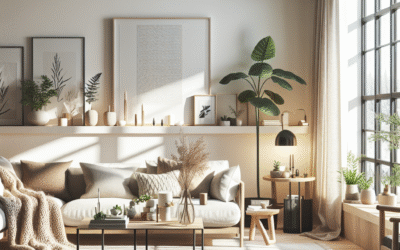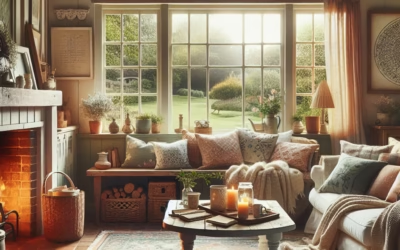
Introduction
Urban living often comes with a unique set of challenges, from limited space to the need for multifunctional designs. One solution that stands out in today’s design landscape is modern industrial design. This style combines raw materials, functional layouts, and vintage elegance, creating spaces that are not only beautiful but also practical.
In this article, you will explore the core principles of modern industrial design, learn how it can be effectively implemented in urban settings, and discover exciting trends that can elevate your living experience. By the end, you should have actionable insights that can transform your space into a modern industrial haven.
Here’s what you can expect to learn:
- The key elements of modern industrial design
- Practical tips for incorporating this style in small spaces
- Current trends and future directions in urban industrial aesthetics
- Real-world examples and case studies of successful designs
Understanding Modern Industrial Design
Modern industrial design draws its inspiration from warehouses and factories, emphasizing materials like metal, wood, and concrete. This style is characterized by:
- Raw Materials: Exposed brick and ductwork showcase the building’s framework.
- Open Spaces: High ceilings and open floor plans offer visibility and flow.
- Functional Furniture: Pieces are often both stylish and functional, designed for everyday use.
The Origin Story
Modern industrial design emerged in the late 20th century as artists sought to repurpose former factories and warehouses into livable spaces. This embraced both the aesthetic of ‘better left unfinished’ and a sustainable ethos of recycling and reusing materials.
Key Principles
Four main principles define modern industrial design:
- Minimalism: Clutter is minimized; each item should serve a purpose.
- Contrast: Combining raw and refined elements makes a visual statement.
- Layering: Textures and colors are layered for depth and warmth.
- Functionality: Every design choice supports the space’s utility.
Implementing Modern Industrial Design in Urban Spaces
In urban environments, where every square inch counts, implementing modern industrial design requires a strategic approach. Here are some practical steps to create an engaging industrial aesthetic in any small space:
1. Embrace a Neutral Palette
A neutral color scheme can make a small room feel larger and more open. Think shades of white, gray, and beige, contrasted with darker industrial materials like black metal.
2. Use Functional Furniture
Choose furniture that serves multiple purposes. For example, a coffee table that doubles as a storage space not only saves space but elevates design aesthetics.
3. Incorporate Lighting
Industrial-style lighting can act as a focal point. Pendant lights with exposed bulbs are not only functional but also enhance the chic industrial vibe.
4. Create Zones
Define different areas within an open space using rugs, furniture arrangements, and lighting. This adds depth and functionality to urban living.
Current Trends in Modern Industrial Design
Staying updated with trends can inspire you to refine your space further. Here are a few standout trends in modern industrial design:
Sustainability
There’s a growing emphasis on sustainable materials. Reclaimed wood and eco-friendly furnishings are gaining popularity, aligning aesthetics with environmental responsibility.
Mixing Styles
Homeowners are increasingly blending industrial designs with bohemian or minimalistic elements for a unique touch. This trend encourages individual expression while maintaining an industrial base.
Smart Technology
Smart home devices are becoming integral, allowing for a seamless blend of modern technology with industrial design. Imagine controlling your lights or thermostat with a voice command while enjoying the timeless aesthetics.
Personalization
More than ever, individuals are making their spaces personal through artwork, unique décor, and custom furniture. Personalized touches breathe life into the industrial framework.
Case Studies of Modern Industrial Design
Let’s explore some real-world examples that epitomize modern industrial design:
Case Study 1: A New York Loft
A Brooklyn loft transformed from a derelict space showcases exposed beams and large windows. The owners used reclaimed wood for furnishings and paired it with metal accents, creating a warm yet industrial atmosphere.
Case Study 2: An Urban Boutique Hotel
A San Francisco boutique hotel masterfully integrated industrial design with luxury. The lobby features concrete floors, vintage furniture, and lush greenery, inviting guests into a sophisticated industrial space.
Case Study 3: Small Apartment Living
A tight urban apartment is made spacious with mirrored furniture and a minimalist approach. A sliding bookshelf serves as a room divider, emphasizing both functionality and style.
Conclusion & Next Steps
Modern industrial design offers a unique solution for urban living, merging aesthetics with functionality. By embracing its principles and trends, you can enhance your space significantly. Remember, there’s no one-size-fits-all approach—your personal style should always shine through.
Want to dive deeper? Check out our related articles on urban decor and DIY design tips to transform your space even further!
Frequently Asked Questions
What materials define modern industrial design?
Modern industrial design primarily uses materials like steel, wood, concrete, and glass. These elements emphasize a raw and minimalist aesthetic.
Can industrial design work in small spaces?
Absolutely! Industrial design can make small spaces feel larger through open layouts, multifunctional furniture, and neutral color palettes.
How to achieve an industrial look on a budget?
Use repurposed materials, DIY furniture, and second-hand items from thrift stores or estate sales to achieve an industrial look without breaking the bank.
Is modern industrial design suitable for homes with children?
Yes! With durable materials and functional furniture, modern industrial design can be both stylish and practical for families.
How do I maintain an industrial space?
Regular cleaning and maintenance of raw surfaces and metal fixtures will keep the space looking fresh. Consider a protective coat for wood to prevent wear.
Content Disclaimer
This article provides information for educational purposes. For specific advice tailored to your circumstances, please consult professionals in design and architecture.
Categories
- Accent Walls & Ceilings (61)
- Art Curation & Gallery (62)
- Bedding Style Trends (68)
- Bedroom Makeover (81)
- Bohemian & Eclectic Styles (58)
- DIY & Budget-Friendly Decor (66)
- Eco-Friendly Design (62)
- Furniture Care (71)
- Home Decor & Design Ideas (165)
- Home Wellness Spaces (59)
- Integrated Outdoor Living (67)
- Japandi Style (61)
- Kids and Nursery Decor (59)
- Living Room Decor (79)
- Mix & Match Techniques (73)
- Modern & Contemporary Design (66)
- Rug Sizing & Placement (73)
- Scandinavian Design Inspiration (20)
- Seasonal Home Decor (80)
- Small Space Solutions (73)
- Wall Art & Painting Tips (77)
Recent Comments
Archives
Product Gallery
-
Large Area Green Rugs for Bedroom Nordic Living Room Decoration Shaped Carpet Irregular Plush Lounge Rug Home Thick Washable Mat
Rated 5.00 out of 5$36.00 – $225.00Price range: $36.00 through $225.00 -
Nordic Style Rugs for Bedroom Morandi Living Room Decoration Carpet Large Area Geometry Lounge Rug Home Cloakroom Non-slip Mat
Rated 5.00 out of 5$26.00 – $387.00Price range: $26.00 through $387.00 -
Irregular Shapes Living Room Decoration Carpet Modern Style Rugs for Bedroom Home Thicken Plush Rug Fluffy Soft Lounge Floor Mat
Rated 4.85 out of 5$37.00 – $225.00Price range: $37.00 through $225.00














